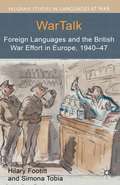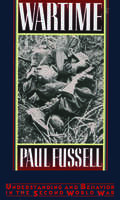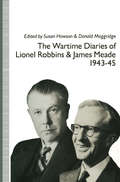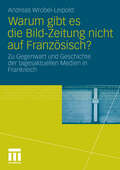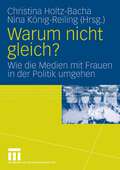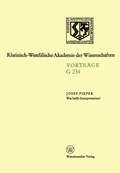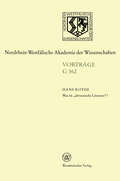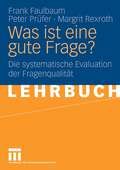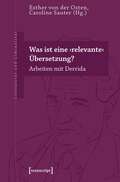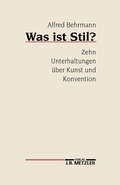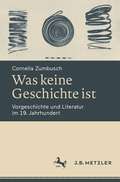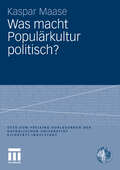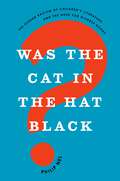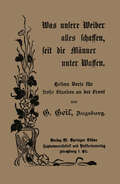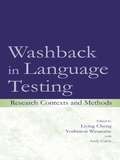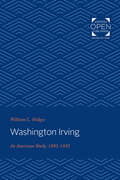- Table View
- List View
WarTalk: Foreign Languages and the British War Effort in Europe, 1940-47 (Palgrave Studies in Languages at War)
by Hilary Footitt Simona TobiaOffering a new perspective on the British experience of the Second World War in Europe, this book provides a series of snapshots of the role which languages played in the key processes of British war-making, moving from frameworks of perception and intelligence gathering, through to liberation/occupation, and on to the aftermath of conflict.
Wartime: Understanding and Behavior in the Second World War
by Paul FussellWinner of both the National Book Award for Arts and Letters and the National Book Critics Circle Award for Criticism, Paul Fussell's The Great War and Modern Memory was one of the most original and gripping volumes ever written about the First World War. Frank Kermode, in The New York Times Book Review, hailed it as "an important contribution to our understanding of how we came to make World War I part of our minds," and Lionel Trilling called it simply "one of the most deeply moving books I have read in a long time." In its panaramic scope and poetic intensity, it illuminated a war that changed a generation and revolutionized the way we see the world. Now, in Wartime, Fussell turns to the Second World War, the conflict he himself fought in, to weave a narrative that is both more intensely personal and more wide-ranging. Whereas his former book focused primarily on literary figures, on the image of the Great War in literature, here Fussell examines the immediate impact of the war on common soldiers and civilians. He describes the psychological and emotional atmosphere of World War II. He analyzes the euphemisms people needed to deal with unacceptable reality (the early belief, for instance, that the war could be won by "precision bombing," that is, by long distance); he describes the abnormally intense frustration of desire and some of the means by which desire was satisfied; and, most important, he emphasizes the damage the war did to intellect, discrimination, honesty, individuality, complexity, ambiguity and wit. Of course, no Fussell book would be complete without some serious discussion of the literature of the time. He examines, for instance, how the great privations of wartime (when oranges would be raffled off as valued prizes) resulted in roccoco prose styles that dwelt longingly on lavish dinners, and how the "high-mindedness" of the era and the almost pathological need to "accentuate the positive" led to the downfall of the acerbic H.L. Mencken and the ascent of E.B. White. He also offers astute commentary on Edmund Wilson's argument with Archibald MacLeish, Cyril Connolly's Horizon magazine, the war poetry of Randall Jarrell and Louis Simpson, and many other aspects of the wartime literary world. Fussell conveys the essence of that wartime as no other writer before him. For the past fifty years, the Allied War has been sanitized and romanticized almost beyond recognition by "the sentimental, the loony patriotic, the ignorant, and the bloodthirsty." Americans, he says, have never understood what the Second World War was really like. In this stunning volume, he offers such an understanding.
Wartime: Understanding and Behavior in the Second World War
by Paul FussellWinner of both the National Book Award for Arts and Letters and the National Book Critics Circle Award for Criticism, Paul Fussell's The Great War and Modern Memory was one of the most original and gripping volumes ever written about the First World War. Frank Kermode, in The New York Times Book Review, hailed it as "an important contribution to our understanding of how we came to make World War I part of our minds," and Lionel Trilling called it simply "one of the most deeply moving books I have read in a long time." In its panaramic scope and poetic intensity, it illuminated a war that changed a generation and revolutionized the way we see the world. Now, in Wartime, Fussell turns to the Second World War, the conflict he himself fought in, to weave a narrative that is both more intensely personal and more wide-ranging. Whereas his former book focused primarily on literary figures, on the image of the Great War in literature, here Fussell examines the immediate impact of the war on common soldiers and civilians. He describes the psychological and emotional atmosphere of World War II. He analyzes the euphemisms people needed to deal with unacceptable reality (the early belief, for instance, that the war could be won by "precision bombing," that is, by long distance); he describes the abnormally intense frustration of desire and some of the means by which desire was satisfied; and, most important, he emphasizes the damage the war did to intellect, discrimination, honesty, individuality, complexity, ambiguity and wit. Of course, no Fussell book would be complete without some serious discussion of the literature of the time. He examines, for instance, how the great privations of wartime (when oranges would be raffled off as valued prizes) resulted in roccoco prose styles that dwelt longingly on lavish dinners, and how the "high-mindedness" of the era and the almost pathological need to "accentuate the positive" led to the downfall of the acerbic H.L. Mencken and the ascent of E.B. White. He also offers astute commentary on Edmund Wilson's argument with Archibald MacLeish, Cyril Connolly's Horizon magazine, the war poetry of Randall Jarrell and Louis Simpson, and many other aspects of the wartime literary world. Fussell conveys the essence of that wartime as no other writer before him. For the past fifty years, the Allied War has been sanitized and romanticized almost beyond recognition by "the sentimental, the loony patriotic, the ignorant, and the bloodthirsty." Americans, he says, have never understood what the Second World War was really like. In this stunning volume, he offers such an understanding.
The Wartime Diaries of Lionel Robbins and James Meade, 1943–45
by Lionel Robbins James MeadeCovering the period 1943-45, these diaries cover issues such as the Bretton Woods UN Monetary Conference in 1944 and loan negotiations and the ITO, as recorded by Meade and Robbins.
Warum gibt es die Bild-Zeitung nicht auf Französisch?: Zu Gegenwart und Geschichte der tagesaktuellen Medien in Frankreich
by Andreas Wrobel-LeipoldFrankreich hält Platz 43 auf der weltweiten Rangliste der Pressefreiheit von "Reporter ohne Grenzen" - hinter Surinam aber noch vor den Kapverden. Der französische Rechtsstaat hat ein eigenes Verständnis von Medienfreiheit. Das sollte auch Journalisten und Medienmanagern in den Nachbarländern zu denken geben, denn über die Europäische Union werden französische Auffassungen zunehmend europaweit verbindlich.
Warum nicht gleich?: Wie die Medien mit Frauen in der Politik umgehen
by Christina Holtz-Bacha Nina König-ReilingLange wurde darüber geklagt, dass Politikerinnen in den Medien unzureichend Beachtung finden - und wenn über sie berichtet wird, spielt ihr Äußeres eine größere Rolle als ihre politische Arbeit. Mittlerweile sind Frauen in der Politik häufiger vertreten als noch vor einigen Jahren und sie befinden sich dort vermehrt auch auf Positionen, die als Männerdomänen galten. Die Beiträge dieses Bandes gehen der Frage nach, ob sich der Umgang der Medien mit Politikerinnen geändert hat, wie heute über Frauen in der Politik berichtet wird, ob es immer noch Grund zur Klage gibt und – wenn das so ist – woran das liegt.
Warum wir die Medien nicht verstehen - und sie uns nicht (essentials)
by Gabriele HooffackerWarum berichten Medien über manche Themen und über manche nicht? Warum missfallen uns manche Nachrichten und erst recht manche Kommentare? Was führt zu Verzerrungen der Wahrnehmung beim Publikum - und auch bei Journalistinnen und Journalisten? Der Band bietet Wissenswertes aus Redaktionen und Journalismus-Ausbildung und gibt Einblicke in die Wahrnehmungspsychologie, etwa den Hostile Media Effekt oder den Third-Person- Effect. Ziel ist, fundierte Medienkritik zu ermöglichen.
Was heißt Interpretation?: Gemeinsame Sitzung der Klasse für Geisteswissenschaften und der Klasse für Natur-, Ingenieur- und Wirtschaftswissenschaften am 27. September 1978 in Düsseldorf. Leo-Brandt-Votrag (Rheinisch-Westfälische Akademie der Wissenschaften #234)
by Josef PieperWas Huck Black?: Mark Twain and African-American Voices
by Shelley Fisher FishkinPublished in 1884, Huck Finn has become one of the most widely taught novels in American curricula. But where did Huckleberry Finn come from, and what made it so distinctive? Shelley Fisher Fishkin suggests that in Huckleberry Finn, more than in any other work, Mark Twain let African-American voices, language, and rhetorical traditions play a major role in the creation of his art. In Was Huck Black?, Fishkin combines close readings of published and unpublished writing by Twain with intensive biographical and historical research and insights gleaned from linguistics, literary theory, and folklore to shed new light on the role African-American speech played in the genesis of Huckleberry Finn. Given that book's importance in American culture, her analysis illuminates, as well, how the voices of African-Americans have shaped our sense of what is distinctively "American" about American literature. Fishkin shows that Mark Twain was surrounded, throughout his life, by richly talented African-American speakers whose rhetorical gifts Twain admired candidly and profusely. A black child named Jimmy whom Twain called "the most artless, sociable and exhaustless talker I ever came across" helped Twain understand the potential of a vernacular narrator in the years before he began writing Huckleberry Finn, and served as a model for the voice with which Twain would transform American literature. A slave named Jerry whom Twain referred to as an "impudent and satirical and delightful young black man" taught Twain about "signifying"--satire in an African-American vein--when Twain was a teenager (later Twain would recall that he thought him "the greatest man in the United States" at the time). Other African-American voices left their mark on Twain's imagination as well--but their role in the creation of his art has never been recognized. Was Huck Black? adds a new dimension to current debates over multiculturalism and the canon. American literary historians have told a largely segregated story: white writers come from white literary ancestors, black writers from black ones. The truth is more complicated and more interesting. While African-American culture shaped Huckleberry Finn, that novel, in turn, helped shape African-American writing in the twentieth century. As Ralph Ellison commented in an interview with Fishkin, Twain "made it possible for many of us to find our own voices." Was Huck Black? dramatizes the crucial role of black voices in Twain's art, and takes the first steps beyond traditional cultural boundaries to unveil an American literary heritage that is infinitely richer and more complex than we had thought.
Was Huck Black?: Mark Twain and African-American Voices
by Shelley Fisher FishkinPublished in 1884, Huck Finn has become one of the most widely taught novels in American curricula. But where did Huckleberry Finn come from, and what made it so distinctive? Shelley Fisher Fishkin suggests that in Huckleberry Finn, more than in any other work, Mark Twain let African-American voices, language, and rhetorical traditions play a major role in the creation of his art. In Was Huck Black?, Fishkin combines close readings of published and unpublished writing by Twain with intensive biographical and historical research and insights gleaned from linguistics, literary theory, and folklore to shed new light on the role African-American speech played in the genesis of Huckleberry Finn. Given that book's importance in American culture, her analysis illuminates, as well, how the voices of African-Americans have shaped our sense of what is distinctively "American" about American literature. Fishkin shows that Mark Twain was surrounded, throughout his life, by richly talented African-American speakers whose rhetorical gifts Twain admired candidly and profusely. A black child named Jimmy whom Twain called "the most artless, sociable and exhaustless talker I ever came across" helped Twain understand the potential of a vernacular narrator in the years before he began writing Huckleberry Finn, and served as a model for the voice with which Twain would transform American literature. A slave named Jerry whom Twain referred to as an "impudent and satirical and delightful young black man" taught Twain about "signifying"--satire in an African-American vein--when Twain was a teenager (later Twain would recall that he thought him "the greatest man in the United States" at the time). Other African-American voices left their mark on Twain's imagination as well--but their role in the creation of his art has never been recognized. Was Huck Black? adds a new dimension to current debates over multiculturalism and the canon. American literary historians have told a largely segregated story: white writers come from white literary ancestors, black writers from black ones. The truth is more complicated and more interesting. While African-American culture shaped Huckleberry Finn, that novel, in turn, helped shape African-American writing in the twentieth century. As Ralph Ellison commented in an interview with Fishkin, Twain "made it possible for many of us to find our own voices." Was Huck Black? dramatizes the crucial role of black voices in Twain's art, and takes the first steps beyond traditional cultural boundaries to unveil an American literary heritage that is infinitely richer and more complex than we had thought.
Was ist „altrussische Literatur“? (Nordrhein-Westfälische Akademie der Wissenschaften #362)
by Hans RotheWas ist eine gute Frage?: Die systematische Evaluation der Fragenqualität
by Frank Faulbaum Peter Prüfer Margrit RexrothDie Qualität von Fragen stellt eine wichtige Determinante der Qualität von Umfragedaten dar. Das Buch präsentiert erstmals in deutscher Sprache ein Fragebewertungssystem mit einem detaillierten Katalog möglicher Probleme in Entwürfen von Fragen, die an Hand von über 100 Beispielen - überwiegend aus bekannten Bevölkerungsumfragen - beschrieben und erläutert werden. Ziel des Fragebewertungssystems (FBS) ist, mögliche Qualitätsgefährdungen in Fra-gen schon frühzeitig vor dem Einsatz empirischer Testverfahren zu erkennen, um damit die Voraussetzung für ihre Minimierung zu schaffen. In das System sind langjährige Erfahrungen der Autoren in der Fragebogenberatung und in der Evaluation von Fragen eingeflossen. Dem Bewertungssystem ist ein theoretischer Teil mit einer umfassenden Einführung in die unter-schiedlichen Aspekte der Fragenqualität und ihrer Gefährdungsursachen vorangestellt, wobei der Qualitätsbegriff nicht nur auf den Aspekt des Fragetextes bezogen wird, sondern darüber hinaus auf alle übrigen Aspekte der Frage einschließlich ihrer Ausführungsmodalitäten (mo-des) sowie ihrer Bedeutung für die Umfragequalität. Das Buch wendet sich an alle, die in ir-gendeiner Weise selber Fragebögen entwickeln oder diese beurteilen müssen. Es eignet sich außerdem für den Einsatz in der Lehre.
Was ist eine ›relevante‹ Übersetzung?: Arbeiten mit Derrida (Literalität und Liminalität #31)
by Esther Von Der Osten Caroline SauterJacques Derridas Text »Qu'est-ce qu'une traduction ›relevante‹?« ist im deutschen Sprachraum zwar bekannt, aber bisher wenig rezipiert. Mit einigen »Wörtern auf tr.« arbeitend - etwa Transfer, Transaktion, Transformation -, entfaltet Derrida in seiner Lektüre von Shakespeares The Merchant of Venice die dem Stück inhärente Kritik der Ökonomien der Transaktion, Übersetzung und Konversion. Er fragt danach, was der Konvertierbarkeit widersteht, und kommt auf seine eigene Übersetzung von Hegels Begriff der »Aufhebung« durch »relève« zu sprechen. Der Band macht diesen Text nun, zusammen mit dem französischen Original, erstmals vollständig in deutscher Übersetzung zugänglich und erschließt ihn literaturwissenschaftlich.
Was keine Geschichte ist: Vorgeschichte und Literatur im 19. Jahrhundert
by Cornelia ZumbuschUnter Vorgeschichte versteht man gewöhnlich die Geschichte der Menschen vor dem Einsatz schriftlicher Zeugnisse. In Bezug auf literarische Erzählungen hingegen meint Vorgeschichte das, was zwar vor dem Anfang der Geschichte geschehen ist, aber erst später erzählt wird. Ein zentraler Text für die Erforschung der Vorgeschichte sowohl in der prähistorischen Archäologie als auch in der Narratologie ist die homerische Odyssee. Am Leitfaden der Homer-Rezeption geht die Studie deshalb den Formen der Vorgeschichte im 19. Jahrhundert nach. Wie wird Vorgeschichte zum Gegenstand der Wissenschaften? Warum erzählen Romane von Goethe, Stifter und Fontane nicht nur Geschichten, sondern auch in diese eingelagerte Vorgeschichten? Und in welchem Zusammenhang steht diese Erzählform mit dem auffälligen Interesse der Literatur an Altertümern und prähistorischen Relikten?
Was machen Menschen und Medien?: Grundzüge einer praxistheoretischen Perspektive für Kommunikationswissenschaft und Medienforschung
by Wolfgang Reißmann Christian Pentzold Peter GentzelDie Rede von Praktiken ist in der Kommunikations- und Medienwissenschaft weit verbreitet. Eine systematische Diskussion des Potenzials praxistheoretischer Denk- und Forschungsansätze steht dagegen noch aus. Dieses Buch ist eine Einladung zur tieferen Beschäftigung mit Medienpraktiken und wirbt für eine entsprechende Neuorientierung von Kommunikationsforschung und Medienanalyse. Dazu wird der Status quo praxistheoretischer Ansätze in der Kommunikations- und Medienwissenschaft kompakt vorgestellt. Interessierte bekommen einen Einstieg und Expert:innen werden Anschlussmöglichkeiten angeboten. Es geht sowohl um Grundprinzipien praxistheoretischen Denkens als auch um die sich daraus ergebenden Haltungen sowie um Zugänge für praktische Untersuchungen. Im Zentrum stehen aktuelle Herausforderungen und die Möglichkeiten, Praktiken in Digitalmedien und vernetzten Medienumgebungen zu analysieren.
Was macht Populärkultur politisch? (Otto von Freising-Vorlesungen der Katholischen Universität Eichstätt-Ingolstadt)
by Kaspar MaaseIn seiner „Legende von der Entstehung des Buches Taoteking auf dem Weg des Laotse in die Emigration“ macht Bertolt Brecht am Ende darauf aufmerksam, dass wir diese Schrift nicht allein der Weisheit des Laotse verdanken, sondern auch der neugierigen F- derung des Zöllners, der den Meister zum Aufschreiben nötigte. Die Schlusszeilen lauten: „Darum sei der Zöllner auch bedankt: / Er hat sie [die Weisheit] ihm abverlangt.“ Nun will der Autor dieses Bandes weder sich mit dem großen - otse noch die Katholische Universität Eichstätt-Ingolstadt mit dem chinesischen Zolleinnehmer vergleichen. Doch nachdem die Texte endlich in die Druckfassung gebracht waren, wurde dem Verfasser klar, dass auch hier das freundlich insistierende Verlangen von außen einen wesentlichen Anteil am Ergebnis hat. So ist an dieser Stelle der Geschichts- und Gesellschaftswiss- schaftlichen Fakultät der genannten Universität nicht allein dafür zu danken, dass sie mir die Ehre erwiesen hat, mich im Somm- semester 2009 mit der Otto von Freising-Gastprofessur zu betr- en. Und es ist nicht nur ein Kompliment an die Studierenden ab- statten, die in den Lehrveranstaltungen meine Gesprächspartner waren. Es ist gleichermaßen die Idee zu preisen, nach der die E- geladenen zwei öffentliche Vorträge unter einer gemeinsamen Fragestellung halten und dann daraus auch noch eine Publikation machen sollen.
Was the Cat in the Hat Black?: The Hidden Racism of Children's Literature, and the Need for Diverse Books
by Philip NelRacism is resilient, duplicitous, and endlessly adaptable, so it is no surprise that America is again in a period of civil rights activism. A significant reason racism endures is because it is structural: it's embedded in culture and in institutions. One of the places that racism hides-and thus perhaps the best place to oppose it-is books for young people. Was the Cat in the Hat Black? presents five serious critiques of the history and current state of children's literature tempestuous relationship with both implicit and explicit forms of racism. The book fearlessly examines topics both vivid-such as The Cat in the Hat's roots in blackface minstrelsy-and more opaque, like how the children's book industry can perpetuate structural racism via whitewashed covers even while making efforts to increase diversity. Rooted in research yet written with a lively, crackling touch, Nel delves into years of literary criticism and recent sociological data in order to show a better way forward. Though much of what is proposed here could be endlessly argued, the knowledge that what we learn in childhood imparts both subtle and explicit lessons about whose lives matter is not debatable. The text concludes with a short and stark proposal of actions everyone-reader, author, publisher, scholar, citizen- can take to fight the biases and prejudices that infect children's literature. While Was the Cat in the Hat Black? does not assume it has all the answers to such a deeply systemic problem, its audacity should stimulate discussion and activism.
Was unsere Weiber alles schaffen, seit die Männer unter Waffen
by G. GeilDieser Buchtitel ist Teil des Digitalisierungsprojekts Springer Book Archives mit Publikationen, die seit den Anfängen des Verlags von 1842 erschienen sind. Der Verlag stellt mit diesem Archiv Quellen für die historische wie auch die disziplingeschichtliche Forschung zur Verfügung, die jeweils im historischen Kontext betrachtet werden müssen. Dieser Titel erschien in der Zeit vor 1945 und wird daher in seiner zeittypischen politisch-ideologischen Ausrichtung vom Verlag nicht beworben.
Washback in Language Testing: Research Contexts and Methods
by Liying Cheng Yoshinori Watanabe Andy CurtisWashback refers to the influence of language testing on teaching and learning. This volume, at the important intersection of language testing and teaching practices, presents theoretical, methodological, and practical guidance for current and future washback studies. In the field of language testing, researchers' major interest has traditionally been focused on issues and solving problems inherent in tests in order to increase their reliability and validity. However, the washback effect goes well beyond the test itself to include factors, such as curriculum, teacher and learner behaviors inside and outside the classroom, their perceptions of the test, and how test scores are used. Only recently have researchers started to empirically investigate the phenomenon of washback. This volume of such research serves two essential purposes by:*providing an overview of the complexity of washback and the various contextual factors entangled within testing, teaching, and learning; and *presenting empirical studies from around the world that offer insights into the effects of washback in specific educational contexts and models of research on which future studies can be based. The extensive use of test scores for various educational and social purposes in society nowadays makes the washback effect a high-interest phenomenon in the day-to-day educational activities of teachers, researchers, program coordinators/directors, policymakers, and others in the field of education. Washback in Language Testing: Research Contexts and Methods is a valuable resource for those who are interested in the application of findings to actual teaching and learning situations or conduct washback research in their own contexts, including educational and psychological testing experts, as well as alternative assessment people in all fields, and for policy- and decision-makers in educational and testing organizations.
Washback in Language Testing: Research Contexts and Methods
by Liying Cheng Yoshinori Watanabe With Andy CurtisWashback refers to the influence of language testing on teaching and learning. This volume, at the important intersection of language testing and teaching practices, presents theoretical, methodological, and practical guidance for current and future washback studies. In the field of language testing, researchers' major interest has traditionally been focused on issues and solving problems inherent in tests in order to increase their reliability and validity. However, the washback effect goes well beyond the test itself to include factors, such as curriculum, teacher and learner behaviors inside and outside the classroom, their perceptions of the test, and how test scores are used. Only recently have researchers started to empirically investigate the phenomenon of washback. This volume of such research serves two essential purposes by:*providing an overview of the complexity of washback and the various contextual factors entangled within testing, teaching, and learning; and *presenting empirical studies from around the world that offer insights into the effects of washback in specific educational contexts and models of research on which future studies can be based. The extensive use of test scores for various educational and social purposes in society nowadays makes the washback effect a high-interest phenomenon in the day-to-day educational activities of teachers, researchers, program coordinators/directors, policymakers, and others in the field of education. Washback in Language Testing: Research Contexts and Methods is a valuable resource for those who are interested in the application of findings to actual teaching and learning situations or conduct washback research in their own contexts, including educational and psychological testing experts, as well as alternative assessment people in all fields, and for policy- and decision-makers in educational and testing organizations.
The Washington, DC Media Corps in the 21st Century: The Source-Correspondent Relationship
by Lea Hellmueller L. HellmüllerThe book provides a fresh perspective on the shifting media landscape within Washington DC, re-evaluating journalist-source relationships, the power dynamic within the media corps, and the ways in which technology have changed the description of DC political news - detailing the ways in which media relationships are changing within Washington DC.
Washington Irving: An American Study, 1802-1832 (Goucher Colloquium)
by William L. HedgesDespite his prolificacy, Washington Irving remained an underexamined figure among literary scholars at the time William L. Hedges published his definitive study of the author in 1965. Most contemporary scholars believed that Irving's central contribution to the American literary tradition was that his work was "polished" and "suave." These scholars maintained that Irving's aristocratic sensibilities defined the stylistic choices of his literary works. To assume this, Hedges contends, is to "both let the man and the work slip beyond one's grasp." Hedges demonstrates that much of Irving's work can be understood in the context of his conflict between federalist and conservative politics. Irving, in other words, found himself incapable of committing to a coherent set of beliefs or attitudes, and this cultural uneasiness manifested itself in his early work. Hedges's book tries to correct some of the misapprehension about Irving's place in nineteenth-century American literature.
Washington Irving: An American Study, 1802-1832 (Goucher Colloquium)
by William L. HedgesOriginally published in 1965. Despite his prolificacy, Washington Irving remained an underexamined figure among literary scholars at the time William L. Hedges published his definitive study of the author in 1965. Most contemporary scholars believed that Irving's central contribution to the American literary tradition was that his work was "polished" and "suave." These scholars maintained that Irving's aristocratic sensibilities defined the stylistic choices of his literary works. To assume this, Hedges contends, is to "both let the man and the work slip beyond one's grasp." Hedges demonstrates that much of Irving's work can be understood in the context of his conflict between federalist and conservative politics. Irving, in other words, found himself incapable of committing to a coherent set of beliefs or attitudes, and this cultural uneasiness manifested itself in his early work. Hedges's book tries to correct some of the misapprehension about Irving's place in nineteenth-century American literature.
Washington Irving: An American Study, 1802-1832 (Goucher Colloquium)
by William L. HedgesOriginally published in 1965. Despite his prolificacy, Washington Irving remained an underexamined figure among literary scholars at the time William L. Hedges published his definitive study of the author in 1965. Most contemporary scholars believed that Irving's central contribution to the American literary tradition was that his work was "polished" and "suave." These scholars maintained that Irving's aristocratic sensibilities defined the stylistic choices of his literary works. To assume this, Hedges contends, is to "both let the man and the work slip beyond one's grasp." Hedges demonstrates that much of Irving's work can be understood in the context of his conflict between federalist and conservative politics. Irving, in other words, found himself incapable of committing to a coherent set of beliefs or attitudes, and this cultural uneasiness manifested itself in his early work. Hedges's book tries to correct some of the misapprehension about Irving's place in nineteenth-century American literature.
